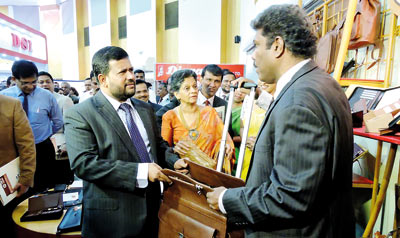Footwear investors from Kenya and Oman look for SL partners to start plants there

Managing Director PG Martin Industries LTD P.G.D. Nimalasiri displaying an export quality bag to Minister Rishad Bathiudeen.
Investors in the footwear business from Oman and Kenya were in Colombo last week looking for Sri Lankan partners interested in setting up manufacturing facilities in those countries. This was revealed during interviews the Business Times (BT) had with foreign companies attending the 8th annual Footwear and Leather Fair 2016 held last week at the BMICH. Speaking at the inauguration of the event, Rishad Bathiudeen, Minister of Industries and Commerce, said Sri Lanka’s footwear and leather exports was on the increase with exports worth US$110 million last year and noted that demand could increase as the middle income group class globally is rising.
The fair was jointly organised by the Sri Lanka Footwear and Leather Products Manufacturers’ Association (SLFLMA), Export Development Board (EDB), Industrial Development Board (IDB) and the Ministry of Industry and Commerce. Mr. Bathiudeen said that the global footwear market is expected to exceed $370 billion by 2020 and thus Sri Lankan footwear exports could also be increased accordingly. He said that though the present demand is for casual footwear, there could also be an increased demand for sports and athletic footwear.
Ms. Indira Malwatte, Chairperson, EDB said that the collaboration of all the stakeholders could improve the footwear and leather industry in Sri Lanka and their efforts could increase the exports. She pointed out that the EDB has identified the potential of this sector many years ago. To augment this effort, she said that they have initiated a number of product and design development programmes.
P.G.D. Nimalasiri, President, SLFLPMA on the side-lines of the event, told the BT that there are more than 30 foreign delegates representing countries like India, Kenya, Oman and the UAE and among them are buyers and sellers. He said that these foreigners know the market and they are in search of competitive, quality products and also search for attractive designs. He said the local requirement is about 40 million pairs and indicated that the local market in 2012 was 80 per cent, but due to some policy changes the proportions changed to 60 per cent local products and 40 per cent imports.
The new government, he said has offered some protection to avoid the influx of imports and mainly consisted of factory over-runs and stock lots. He pointed out that if the influx of imports is not stopped their industry would be unsustainable. Imports come from countries like Vietnam, India, China, Bangladesh, Pakistan, etc. After the inauguration of the fair, Ms. Beatrice Mwasi, Executive Secretary, Leather Articles Entrepreneurs Association, Kenya told the BT that they are visiting the fair to find partners from Sri Lanka to start a shoe manufacturing factory and for that reason they would be visiting several shoe manufacturing factories in this country.
The BT also spoke to Hussein Marzouq Abdullah Alharrasi, Deputy Director, Small and Medium Enterprises Department, Oman Chamber of Commerce and Industry. He said that they have found that the Sri Lankan industry is specialising on shoes and leather and they are visiting this type of exhibitions to find quality products and to set up shoe manufacturing factories in Oman in collaboration with Sri Lankan manufacturers. He said that manufacturers here are using appropriate technology and equipped with better manpower.


